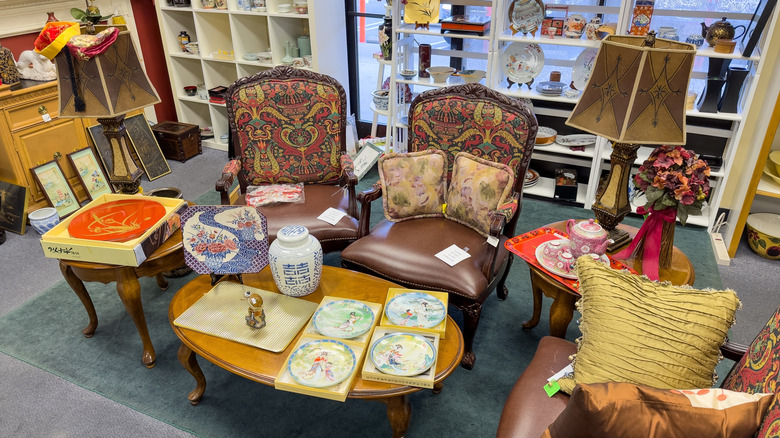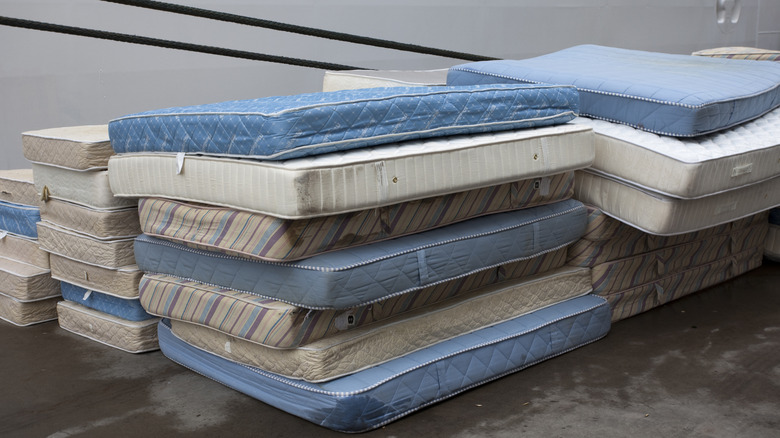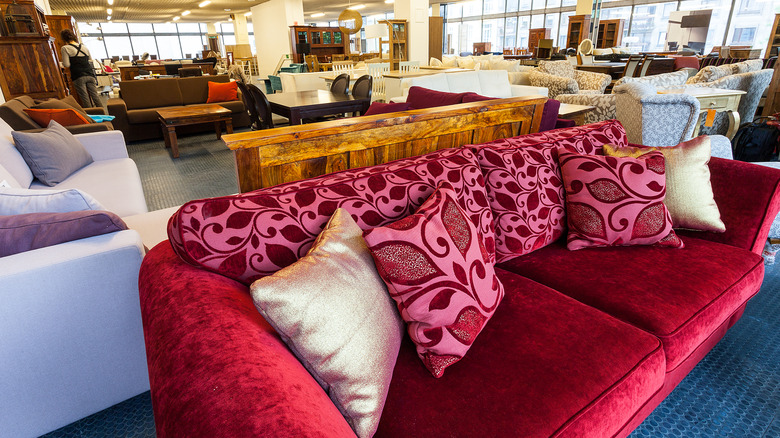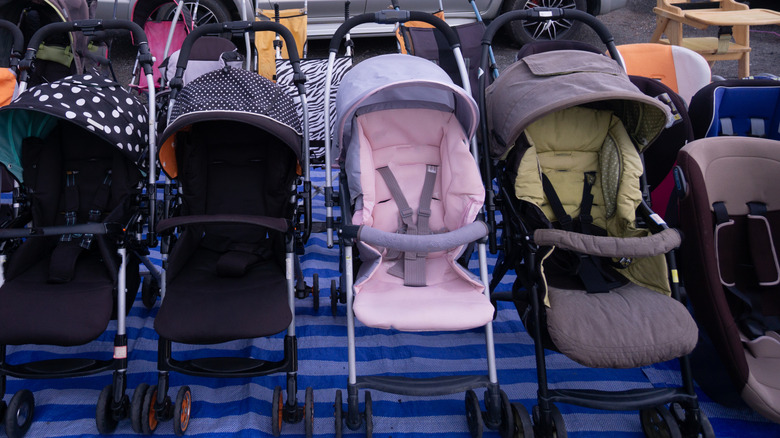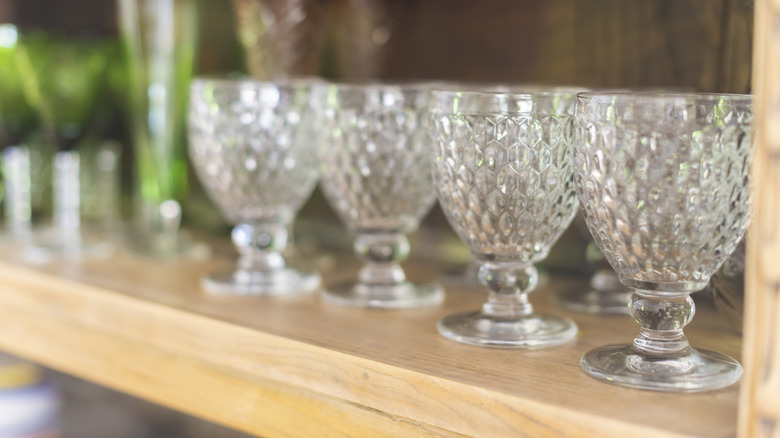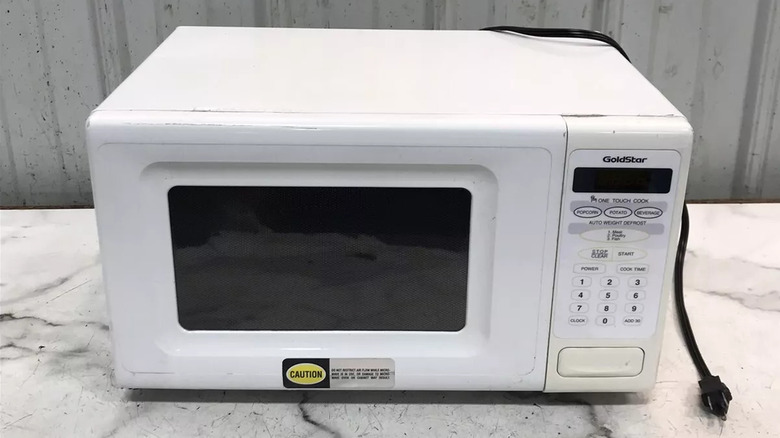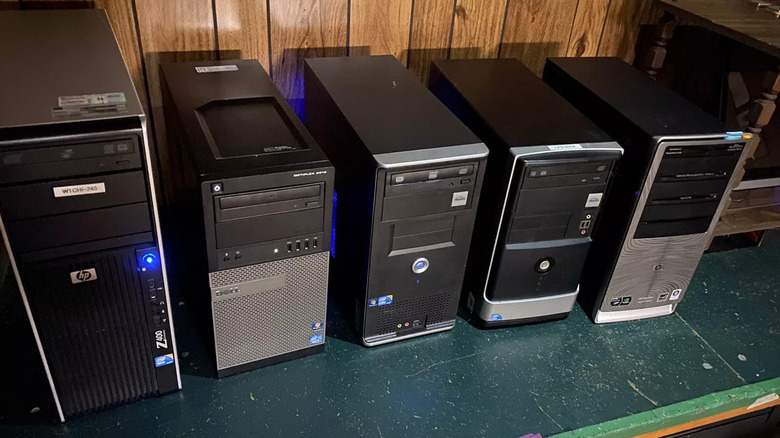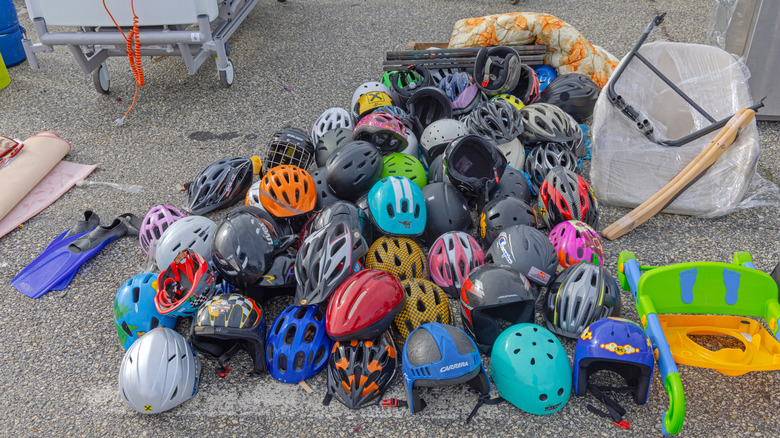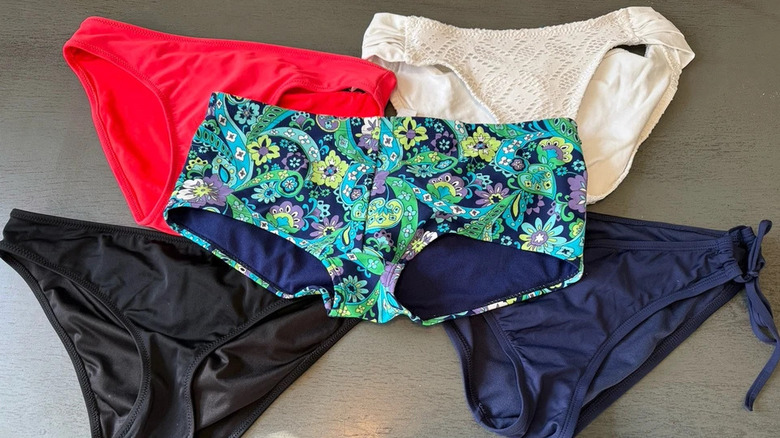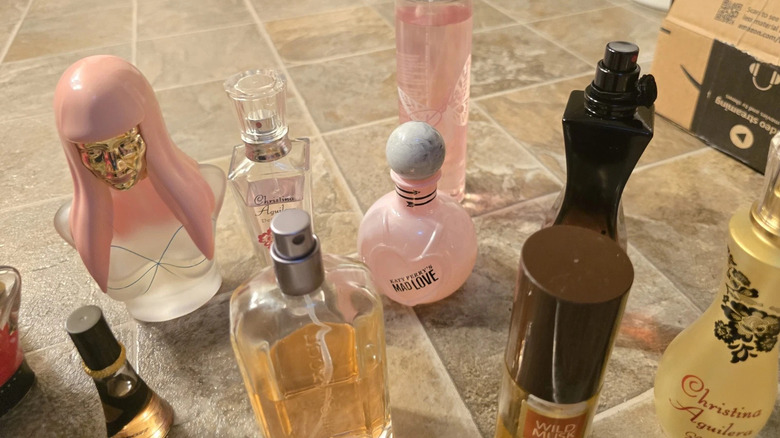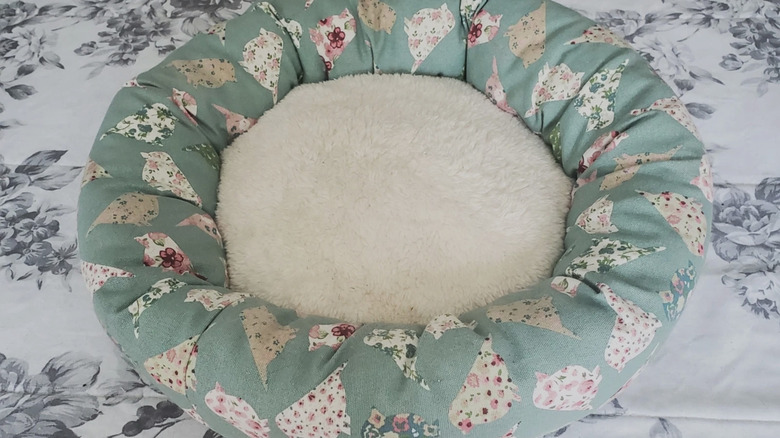10 Things You Should Never Buy At The Thrift Store
Thrift stores are hidden gold mines for treasured collectibles, designer clothes, like-new products, and one-of-a-kind vintage wares. In most cases, purchasing pre-owned items is better for the earth and your wallet. However, there are some thrifty finds to actively avoid. Sometimes, these used items can put a person's health, safety, and overall household at risk. Given this risk, they aren't always worth the extreme cost difference, especially if you aren't prepared to deal with the aftermath.
Below are 10 things you should never buy at a thrift store. Even the heftiest discount doesn't offset the possibility these items are teeming with bacteria or have malfunctioning parts. Thrifted goods usually don't have warranties, and there's either a small return window or none at all. This makes it difficult to recoup the cost of a poor purchase. There are workarounds for some items if you know how to make repairs, replace specific parts, or are willing to do a deep clean once you return home. However, at the end of the day, most of these items are better off bought new. So learn what thrifted items should be avoided, why, and what to do instead.
Used mattresses and pillows from strangers are more dangerous than they look
A new mattress costs anywhere from $100 to $3,500 (or more) depending on the size, materials, and craftsmanship. This can be far out of budget, especially if you need a bigger bed. Thrift store mattresses may come at a much lower price, and although such a high discount can be tempting, there could be consequences to buying this used product.
There's no telling what pre-used mattresses have been through. They may be laden with allergens, bed bugs, dust mites, and bodily fluids. Depending on how old they are, they may also lack support in certain areas. This can lead to discomfort, interrupting your sleep and potentially causing pain and back problems. There's also a chance the mattress is almost at the end of its lifespan since most only last up to 10 years. Essentially, used mattresses seem like a massive discount upfront, but have huge risks and a short lifespan ahead. Valid warranties are likely obsolete, as many mattress warranties only extend to the original purchaser.
With the risks and non-existent safety net (no warranty) of buying a used mattress, think twice before making this investment. The safest place you'll find a used mattress is through a trusted family or friend. Even so, you should fully examine the mattress for bed bugs and eggs. They often nest in corners and seams, and bugs and eggs are visible without a magnifying glass. You should also test that the mattress is comfortable to lay on and doesn't have any dips or rips in the material, which can quickly degrade its comfort and quality.
Secondhand furniture with upholstery could be hiding bugs and bacteria
There are many expert tips for thrifting home furniture and decor. Co-founder and president of Chairish, Anna Brockway, told Forbes, "Vintage furniture costs up to 80% less, is better made and immediately available, and brings character, uniqueness, and style to a room. It is also kinder to the planet." Even previously used furniture from Amazon, Wayfair, and fast furniture sites are priced lower at thrift stores, saving homeowners and renters hundreds to thousands of dollars when furnishing their homes.
So, it may be tempting to buy used furniture but be mindful of upholstered items like cushioned dining chairs and desk chairs, couches, sofas, and other items with fabric accents. Bed bugs are known to hide in these fabrics. Seeing as one in five Americans has come across bed bugs or knows someone who has, they're common enough to be wary about. Another risk of buying used upholstery is that it may contain toxic chemicals. Between the years 1985 to 2010, about 85% of constructed couches were found to contain dangerous chemicals in their foam makeup. These products are now banned in future construction but are still present in older furniture sets.
You don't have to ward off secondhand upholstery completely if you fully inspect the item in question. Bedbugs may have more places to hide depending on how complicated and heavy the furniture piece is. If it's a smaller item, like a detachable cushion to a plastic desk chair, separate the cushion and treat it accordingly. Put it in a sealed bag laid out in the sun for days, effectively baking away any potential bugs. You can also replace fabric pieces if the furniture frame is in good condition. Be wary that bed bugs aren't just present in upholstery. They also hide in the joints of wooden furniture, making infestations possible even without any cushions or fabric lining.
Even gently used baby products may not be up to code
Baby items are notoriously expensive, and they're only going up in price, making it tough for parents to budget for brand-new items. A popular item like a Doona + Car Seat & Stroller is $600 brand new. However, a pre-owned Doona stroller is around half the price, potentially saving hundreds of dollars. It's a similar story for most baby furniture and supplies, which drives parents to thrift even if it's not the best choice.
The biggest concern with used car seats, cribs, high chairs, and strollers is that these items must be designed to keep babies safe. In order to do so, they must be up to code and in proper condition. A pre-owned baby stroller may not appear damaged, but there's no guarantee that there's an issue with a spring, screw, or wheel that could be unsafe for a child. Thrift stores aren't required to test these products or guarantee their safety. Many past models are also outdated according to safety standards.
It's still possible to buy pre-owned baby products, but at the very least, ensure they're up to code. Look up the regulations around all products. For example, only high chairs made after June 2019 have the ASTM International F404 label because this standard wasn't integrated until then. Drop-side cribs were also banned in 2011, meaning you should avoid pre-owned or vintage cribs in this style. Also, stay up to date on recalls. It's illegal to sell recalled items, but the Consumer Product Safety Commission is mainly focused on major retailers, not independent thrift shops.
Vintage glassware could contain lead
Vintage glassware sets have an ornate look and historical background, making them highly valuable among collectors and homeowners. Once identified, certain branded vintage collections are worth hundreds to thousands of dollars, and there are many valuable glass items to look for at thrift stores and estate sales. If the pieces haven't been properly identified, they're sometimes mistakenly labeled for under $5.
Before getting too excited about finding valuable glassware for such a low price, know that experts recommend checking your vintage glassware for lead. Lead in glassware was the norm for centuries since crystal glass was produced using lead and cadmium. These materials are now known to be health risks. This is why modern glassware is now marketed under terms like "lead-free crystal," as most of the public is aware of lead poisoning.
Of course, vintage glassware is much less likely to pose a health risk if you solely intend to use it as decor. If thrifters don't intend to drink from the glass, it's unlikely they'll consume toxic carcinogen levels. The only concern is that when dust builds up on decorative glassware, it also absorbs lead. The dust may be accidentally inhaled when dislodged, making it important to clean these pieces regularly. Vintage glasses may also be deemed usable if their date indicates they're from a younger collection. A back stamp often indicates the date, but not all brands mark their collections clearly. Look for dates in the mid-70s and onward, as United States items after 1971 were regulated to certain amounts of leachable lead. However, beware that this limit is only based on the new condition of an item. Some items expose more lead as their protective glazes and sealants fade, making them more dangerous as they age.
Thrifted electronic appliances may not work correctly or at all
Retailers often sell appliances at up to a 20% profit margin, making them an expensive investment if purchased new. A brand new microwave is easily $80 and up, even when purchased from reputably cheap sites like Amazon. Compare this to the $10 to $20 lightly used microwaves at local thrift stores, and secondhand shops are the obvious answer for saving a quick buck. Even high-demand game consoles can have massive discounts, but keep in mind items are always abandoned for a reason. In the best-case scenario, someone simply didn't want it anymore. The worst case is that it's defunct and donated instead of thrown away. There's often no way to test the batteries or wiring in store. Plus, many people donate or sell their used items without working batteries.
So, it's best to avoid buying electric kitchenwares, office items, entertainment systems, speakers, and other electronically-powered devices. If you're shopping at a larger thrift chain, they may have a refund policy in case your item doesn't work. Electronics can be returned to Goodwill with a receipt within 3 days of purchasing. It also doesn't hurt to ask if you can test the items, as many independent shops will be more than happy to let you, especially if they know it works and they want to make a sale.
Previously owned laptops and personal computers could have hidden defective issues or malware hidden inside
Laptops and personal computers (PCs) are a hot commodity among remote workers, gamers, and casual users alike. Sometimes, you can find these devices for less than $100 at thrift stores, which is a steal compared to electronic retailer prices. Even the cheapest Chromebooks are around $200 to $300 brand new. If a person is lucky enough, they could find a full-size used computer that does more for a fraction of that cost.
Before snatching up a heavily discounted computer or laptop, understand the risks. There's no guarantee that these products last long-term. Even though Goodwill has a 3-day window for returns, a laptop or PC's battery could go out within a few weeks or months. There could also be minor malfunctions in the device that put your data and security at risk. The previous owner could have accidentally infected the device with hidden malware that you're now inheriting. On a final note, whatever manufacturer warranty is attached to the product likely isn't transferable to you, the new owner.
Instead of buying an untested laptop or PC from a thrift shop, go to a major retailer or manufacturer specializing in clearing out old systems for new owners. These companies are experts in refurbishing pre-owned computers and often offer warranties with their products, providing a bigger safety net than a standard thrift store. These prices aren't as low as a secondhand shop but are still better than buying a brand-new device. If you do go with a thrift store PC and have some knowledge in building computers, consider replacing the hard drive with a new version like Seagate IronWolf's 4TB NAS Internal Hard Drive to reduce the risk of malware.
Formerly owned adult and children's helmets could compromise safety
In regards to safety, it's always recommended that children and adults buy helmets that are brand new. Children's helmets are affordable, making them easy to budget for without putting anyone at risk. On the other hand, adult motorcycle, safety, or sports helmets are pricey. Although they may be cheaper used, it's a poor choice since it's detrimental to the wearer's safety.
Helmets sit tight on a person's head, meaning they're likely to retain bacteria, sweat, and even hair from the previous wearer. It may be shaped to the former wearer's head, meaning it won't sit correctly on your head or provide complete protection during an accident. There aren't as many options when thrifting, making it less likely you'll find a good fit. Another concern is that the helmet could've been involved in a crash, even if the visible damage seems minimal. Slight damage can compromise a helmet's structure, and it may not protect its wearer well in another accident.
Helmets are uncommon in thrift stores but still present, and people should be aware of these risks before buying. When thrifting more expensive helmets, such as those made for motorcycles, buy replacement pads and liners. Buy specialized liners for the specific brand, or a universal option like Yzpacc's Uniersal Airsoft Helmet Pads. These pads improve hygiene, and comfort, and make helmets more form-fitting.
Old swimsuits are overall unsanitary
Thrifting for clothes is a beloved hobby for many, as it's a great way to find unique styles for cheap. Social media users love sharing their hundred-dollar finds that cost less than $20 at a thrift store, which really highlights the appeal. Even good-condition clothes from the thrift store need extra care when washing to ensure they're clean and wearable. However, you may want to avoid some articles of clothing even with a thorough cleaning.
Many thrift stores don't wash items before they put them on the rack, and pre-owned swimsuit bottoms are a breeding ground for pubic lice, mites, and pinworms. They may even have bed bugs hidden in the fabric folds. The truth is that you don't know who owned this article of clothing before. It rests against a very intimate part of your body that you likely don't want to be exposed to a stranger's bacteria or bodily fluids. It's also harder to wash and sanitize swimsuits than other articles of clothing since extreme heat can damage the elastic material.
Don't throw away the idea of a thrifted swimsuit altogether. Women's bikini tops are often sold separately. Purchase the top used and try pairing it with a brand-new bottom, which still saves money. Sealing a bathing suit in a plastic bag for one to two weeks also kills many parasites, though this may not eliminate all bacteria and pests.
Almost full bottles of cologne or perfume could be expired
Designer perfumes go for $50 to over $200 brand new. When you spot a familiar bottle for under $5 at a local thrift store, it feels like winning a scratch ticket. As with all beauty and hygiene products, be wary before buying something once owned by a stranger.
Unless the perfume bottle is still sealed, there's no way to guarantee the chemicals inside are safe to wear. They could be counterfeit or tampered with, making it unwise to put on your body, especially if you have sensitive skin. If they're expired, the smell might be fading or not last as long due to the age of the bottle. Kathy Ozzard Chism, author of Garage Sale Secrets, warned AARP readers, "Consider: anything you rub or spray on your body is likely going to enter your bloodstream within about 10 minutes." This statement is something to remember before rubbing a pre-owned fragrance into your skin.
Instead of buying a pre-used perfume, a safer route would be purchasing a new bottle from an outlet store or discount department store like Perfume Outlet or T.J. Maxx. By frequently checking the shelves, you'll likely find discontinued and overstocked perfume lines made by reputable companies at a large discount. They're new, safe to wear, and carry far less risk than a used perfume bottle.
Thrifted pet beds are just as much of a risk as human beds
Even in an age of inflation, people find ways to spoil their pets. Buying a new cat or dog bed can cost upwards of $50, depending on the size and fabric used. However, at thrift stores, you can find well-made but pre-owned pet beds for rock-bottom prices. Although this seems like a steal, you should compare a dog bed to a human mattress before making the purchase.
Consider the risks that come with buying a mattress. There could be bed bugs, fleas, bacteria, bodily fluids, and hair from the previous owner. Even if it looks clean, it could pose a health risk to your pet, household, and home, as the pests and bacteria are unleashed. Dr. Taylor Truitt, DVM, warned PetMD that buying used bedding could also incite misbehavior in cats, explaining, "I wouldn't use cat trees secondhand as they'll have the odor of the other cat, and the cat now using it could start urine marking it."
While thrifting a pet bed is a bad idea, buying one can also be expensive. Fortunately, there are ways to create a stylish and sanitary resting place for pets without breaking the bank. Try turning a pool noodle into a comfy pet bed using things from home or looking for another DIY project that uses low-cost materials.
